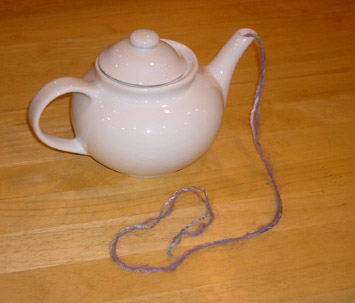
 Some
mornings (okay, most mornings) when
I wake up and face the pile of grocery
bags filled with yarn in my bedroom,
I think I should develop a real system
for yarn storage. Those bags are my
holding tank, waiting until I have
time to put them away. Of course,
some of them have been there for months
-- double-digit months.
Some
mornings (okay, most mornings) when
I wake up and face the pile of grocery
bags filled with yarn in my bedroom,
I think I should develop a real system
for yarn storage. Those bags are my
holding tank, waiting until I have
time to put them away. Of course,
some of them have been there for months
-- double-digit months.
A few weeks ago
I confided in my knitting circle,
and admitted that there must be some
system I should be using. My very
kind circle friends assured me that
the pile-of-yarn-filled-grocery-bags
was indeed a system. But system or
no, it is probably not the most efficient
way of storing stash. So what would
be the best way to organize yarn and
knitting equipment? This led me to
a little research and a few musings.
Sorting Yarn
When deciding how
to sort yarn, I have one main criteria:
what organizational system will make
it easiest to find the yarn I need
when I need it? I don't think I'm
alone in this desire. Of course, the
answer to that question will vary
from knitter to knitter, but there
are three categories that most knitters
use.
- weight (all fingering yarns together,
all sport weight yarns together...)
- color (one box of reds and pinks,
one of blues...)
- type (all the wool yarn together,
all the novelty yarns together, all
the cotton yarns together...)
There are advantages
to each of these methods. If you enjoy
working Fair Isle or intarsia designs,
sorting by weight can be helpful.
With this method, you can quickly
see what you have available in a given
weight that will work well together
in a project. However, if you find
yourself drawn to a particular kind
of project, say knitted items for
babies, you may find that you have
so much fine yarn it is not helpful
at all to store it in one big bin.
In that case, you may choose to sort
by color. This is reminiscent of doing
laundry (but somehow much more fun):
whites, brights and darks may each
have their own container. The advantage
to this system is that it easily expands
or contracts to accommodate your stash.
For instance, you may have a box each
of blues and grays, but as your yarn
supply dwindles, you can consolidate
the skeins into one big blue/gray
box.
Sorting by type
is helpful if you enjoy trying yarn
made of different fibers and are likely
to have leftover yarn made from a
variety of materials. There are two
advantages to this approach. One is
that you will easily be able to select
yarn of a type (e.g. all mohair, all
acrylic) should you choose to mix
yarns from previous projects. This
will make blocking and laundering
easier. Another reason to organize
stash by type is that certain yarns
may require care in storage to assure
they are not damaged.
This issue of appropriate
storage leads us to consider:
Yarn Containers and
Space for Them
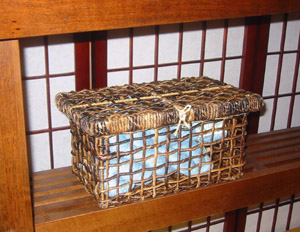
 When
selecting yarn containers, there are
several factors to consider.
When
selecting yarn containers, there are
several factors to consider.
1) What will make it easier to identify
the contents of the container?
2) What will be most appropriate in
preventing damage to the fibers?
3) How much will all these containers
cost?
4) How much space do I have to store
yarns, and where can I eke out more?
For the first item,
identifying contents, the issue is
the same as for sorting: finding the
yarn or equipment and finding it fast.
This can be done either by using transparent
containers, by using baskets and containers
with slats that allow the yarn to
be seen, keeping yarn in plain sight,
or careful labeling. A number of excellent
boxes, bags and baskets are available
at specialty stores such as The Container
Store, Hold Everything, or at discount
department stores.
Secondly, it's important
to store your yarn appropriately to
preserve it from pesky insects, mold
and other pests. Make sure your woolen
yarns are stored with some kind of
anti-moth substance. My favorite is
cedar chips, as the yarn stored with
them comes out smelling even better
than it went in! Similarly, all yarn
should be kept from particularly damp
or warm spaces. While yarn doesn't
mold as quickly as food, it certainly
can and this is especially true for
yarns made from natural fibers.
Because good containers
for yarn storage could, in some instances,
cost even more than the yarn they're
storing, I have a number of knitting
friends who have resorted to creative
recycled or inexpensive containers.
One popular choice is gallon-sized
zip-lock plastic bags. Those made
for freezer storage often have a spot
for labeling where a knitter can record
information about the yarn and when
it was used. This is especially helpful
if the label on the skein is missing.
Other cost-conscious solutions include
dressers, toy chests, canvas bags
or shelving previously used for other
purposes. I have a knitting friend
who swears by her guest-bathroom tub.
This concept appeals to me and I'm
jealous of her guests who have the
opportunity to dive in and wallow
among beautiful yarns.
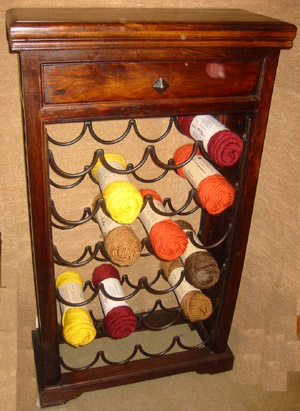
 Recycling
containers doesn't need to be the
end of it. Desperate knitters can
be creative when recycling space as
well. A truly spatially challenged
knitter may begin to reconsider even
the tightest possible areas for yarn
storage. In many cases, containers
already exist that will help exploit
square inches. Some examples include
flattish boxes on wheels meant to
be used under the bed, or small shelving
units (often advertised for college
dorm rooms) sized to fit behind an
open door. Don't forget hanging possibilities.
Using hooks for hangs of yarn, baskets
on the wall or bags on clothes hangers
all can provide ample storage.
Recycling
containers doesn't need to be the
end of it. Desperate knitters can
be creative when recycling space as
well. A truly spatially challenged
knitter may begin to reconsider even
the tightest possible areas for yarn
storage. In many cases, containers
already exist that will help exploit
square inches. Some examples include
flattish boxes on wheels meant to
be used under the bed, or small shelving
units (often advertised for college
dorm rooms) sized to fit behind an
open door. Don't forget hanging possibilities.
Using hooks for hangs of yarn, baskets
on the wall or bags on clothes hangers
all can provide ample storage.
While evaluating
space around your home to stash your
stash, you may reconsider old standbys,
like reorganizing your closet either
on your own or with a professional
organizer. Or, you could go the opposite
route and instead of hiding your fabulous
fiber, flaunt it. Think creatively,
and consider your yarn as a home decoration.
For instance, take your half-used
skeins out of the grocery bags in
your bedroom, put them in beautiful
baskets and relocate them to your
living room. Or move those long hangs
of yarn you just arranged on a set
of hooks in your closet to your wall
as art. Change them around to suit
your mood, or as you knit them up.
A wine rack can show off baguette-shaped
lovely skeins of yarn. Teapots are
a charming way to store smaller balls,
and you need only thread the end through
the spout for tangle-free knitting.
Storing Knitting
Equipment
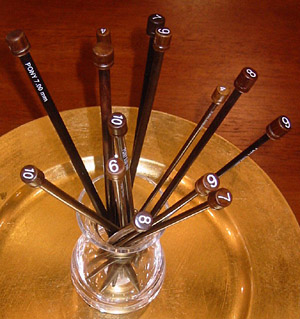
 Like
yarn, you may choose to use more traditional
methods of organization and storage
for your equipment, or you can choose
the path less trodden and display
your equipment decoratively.
Like
yarn, you may choose to use more traditional
methods of organization and storage
for your equipment, or you can choose
the path less trodden and display
your equipment decoratively.
If you want to use
equipment holders made especially
for the purpose, most yarn catalogs
have a wide range of choices of equipment
holders. My own favorite organization
method for circulars is the hanging
canvas holders with horizontal pockets
marked with the needles' sizes. A
friend in my knitting circle stores
them together, but marks them using
a fine-tip permanent marker so she
doesn't have to determine the size
each time she uses one. Or, you may
choose to support a social justice
cause by ordering needle holders through
Lantern
Moon whose profits help support
the Viet Namese women who make them
or the Cambodian
Handicraft Association, run by
survivors of landmines and polio who
hand-dye, spin, weave and sew their
beautiful product.
Imaginative and
thrifty solutions to equipment storage
are many. My Aunt Tootsie uses tall,
round oatmeal containers, and I have
found a silverware separator to be
handy. Dental cases and desktop trays
provide excellent ways to sort and
store smaller knitting equipment such
as stitch holders, stitch markers,
measuring tapes, scissors, and other
odds and ends.
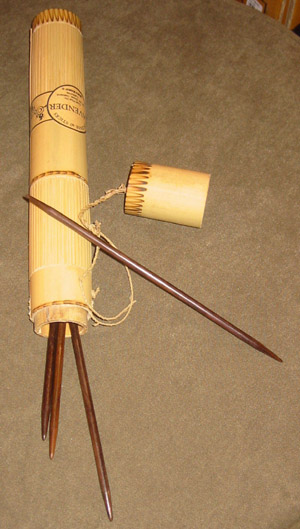
 For
a decorative approach, try glass or
clear pasta canisters to hold knitting
needles. Handsome rosewood or bamboo
needles make an attractive bouquet
for the table during the winter and
fall months, and incense stick holders
are a good way to hide your needles
while still storing them in plain
sight.
For
a decorative approach, try glass or
clear pasta canisters to hold knitting
needles. Handsome rosewood or bamboo
needles make an attractive bouquet
for the table during the winter and
fall months, and incense stick holders
are a good way to hide your needles
while still storing them in plain
sight.
Smaller equipment can
be stored in ornamental ways as well. Those
napkin rings your Aunt Sally gave you that
are still sitting in a drawer? Clip stitch
holders of varying sizes to them so you
can easily find the ones you want. Collect
small vases and attractive paperclip holders
for stitch markers, T pins and knitting
notions. All the public areas of your home
can become knitting storage without your
public even knowing!
Decreasing Stash
On occasion, you
may find that no amount of wrangling
or creativity will accommodate your
extra yarn. In that situation, it
may be time to decrease your stash,
but that is another article. (Or two.
Specifically, Pass
it On, and Overloaded,
or Variety is the Spite of Life,
both by Kate Boyd..)
Regardless of which
methods you choose to sort and store
your knitting things, take a minute
to pat yourself on the back and give
yourself credit for having faced your
problems and addressed them. You can
feel good about bringing orderliness
to your knitting world.
At least until those
grocery bags begin to pile up around
your bed again.

